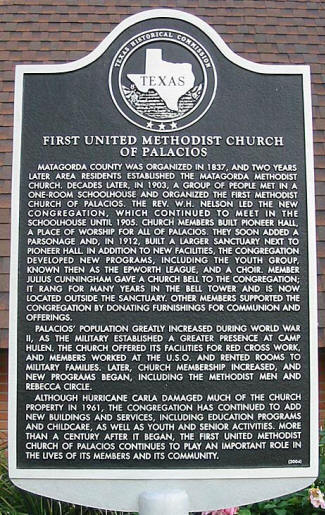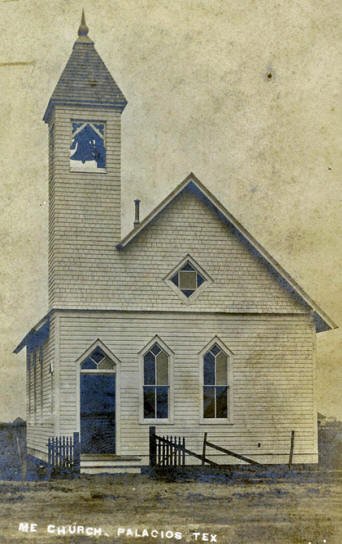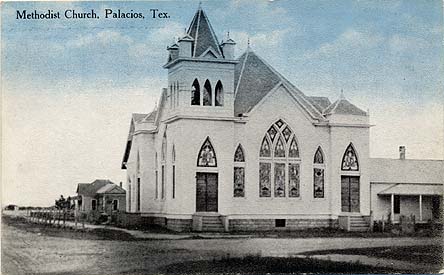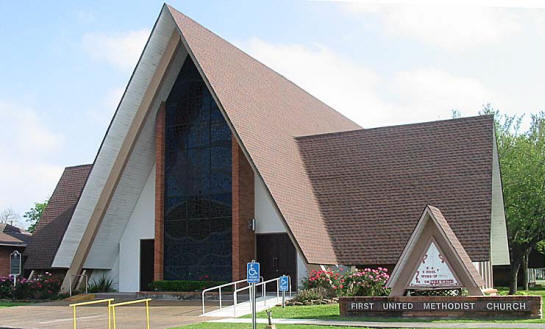|
First United Methodist Church of Palacios
209 Lucas Street
28°42'16.45"N
96°12'46.53"W |
||
|
||
|
In 1903, a group of people met in a one-room schoolhouse and organized the First Methodist Church of Palacios. In the years that followed, the church and its members would endure hurricanes, a depression, two world wars and numerous other hardships. The first pastor of the new church was the Reverend W. H. Nelson. He was taken into the home of the David Baxter family. In the days to follow, Reverend Nelson prepared his sermons and did the organizational work of the church from the top of a sewing machine, which doubled as his desk. Another of the founding families was the Trick family. They moved to Palacios from the state of Oregon to operate a livery stable. Mr. Trick used his horse-drawn hack to transport people wishing to attend church service. The Trick’s son, Arman, was the first child to be born in Palacios. During this early period, the church held its first money-raising project. It was a box supper, which raised $25. After that, money was raised periodically with other events such as ice cream and watermelon socials. The one-room schoolhouse was used for worship until the year 1905. At that time Reverend I. S. Smith aided in building a one-room structure called “Pioneer Hall”. The church became the center of worship for the whole town. A two-room parsonage was built on the east side of the church and over the years it was enlarged, remodeled, and repainted. It served as the parsonage until Hurricane Carla damaged it so badly, it could no longer be used. In 1906, Reverend Carter came to Palacios. He found the infant church still growing. During his ministry, the first youth group was organized. It was called the “Epworth League”. It consisted of 70 people organized into two groups. In 1909, Miss Bessie Belknap became a member of the church. She was a very important asset to the church. She held various offices in the church including many years as the church treasurer. Miss Bessie knew every small detail regarding the money, as well as other aspects of the church. In 1973, after her retirement, Miss Bessie was given a plaque to commemorate her special service. Even that could not express the churches high regard for her. When Methodism was firmly established and the membership outgrew Pioneer Hall, the building was turned around and joined to a concrete foundation on the south side by the pastor Reverend Miller and Oscar Arnold. Upon this foundation, the beautiful sanctuary of the First Methodist Church was begun. It included lovely, leaded, stained glass windows, which added to the feeling of worship. The sanctuary was located on the northeast corner of Third and Lucas Streets and was not completed until January 25, 1912. By 1910 the enrollment of the church had risen to 365, with 91 members in the Epworth League. The first choir was organized and donations were made to pay for a pulpit, chair, and a bell. The bell, given to the church by Julius Cunningham, rang out loud and clear, for many years from the church bell tower, in the old church. It is now located on a scaffold outside the present church. The people of the Carancahua community built their first church in 1910-1911. It was heavily damaged by wind and hail and was later moved to its present location in 1926. In 1931, the church was struck by lightning while being remodeled and was rebuilt into a more compact but very attractive rural church. In 1961, the church was severely damaged by Hurricane Carla, and was again remodeled. It was reopened in 1962 and again the people of the community had a house of worship. In 1973, during the ministry of Rev. Tom Connoly, the people of this community joined the Palacios church to worship. They have added much to the church and the community. The last pastor during the “Pioneer Period” was B. A. Myers. Among his accomplishments were the first church bulletin, cleared church debt, the first envelope offering system and a beautiful communion set, given by the Perry Family (Jim, Guy, and parents). J. A. Callaway gave wooden offering plates to the church. They were hand turned in Houston. On land given to the church by a Mrs. Santos, a Mexican Mission was established. For less than $100, the building was bought and finished. Sunday School and some preaching services were held there. In 1913, this property was traded to the 2nd Presbyterian Church for some land in Hondo. This Presbyterian Church remains a vibrant part of our Christian community of churches today. Thus ended the Pioneer period of our church. The second era, or “middle years” of the church, included a continuation of evangelism and expansion. It included the ending of World War I, the “Great Depression” and all of World War II. The spiritual foundation of the church was firmly established, and though adequate, the physical aspect of our church plant was in need of additional space for Sunday School, youth group and social activities. During this time some pastors preached in rural area schoolhouses including Prairie Center, Turtle Bay, Carancahua, and Olivia. Many of these eventually became part of the local congregation. The pastors of this era were fine, dedicated, and hard working persons but the church reflected great world changes. It was difficult to keep Sunday School attendance up, though attendance at the Mexican mission was good, despite a definite language barrier.
During World War II, attendance and finances increased as the Texas National Guard Camp became a federal army camp–Camp Hulen. The facilities in both the church and town were crowded. The social hall became a Red Cross sewing center, the minister and lay people worked at the U.S.O., and many families rented out rooms so that military families might be with the men stationed here. The church maintained its service to the community. Reverend L. Greenhaw led the church from the middle years into the latter years. He was organized, and active in both civic as well as church affairs. He was pastor in Palacios longer than any of the other pastors. After the war years, the youth became active in the church. The M.Y.F. and choir grew. The youth raised $400 to buy a Hammond organ for the church. The pastor reported that the church was a flourishing, strong happy place with great spiritual growth and in 1944 the first bonds were purchased toward a post war parsonage. During the ministry of Reverend Schulze, Sunday School attendance rose to 174, and the Methodist Men and Rebecca Circle groups were organized. The Rebecca Circle, originally a group for the younger women of the church, was organized under the direction of Mary Friery. They raised money through rummage sales, which became a yearly bazaar. Included in their projects were the redecorating of the nursery, the church parlor and helping to remodel the church kitchen. In 1952, Reverend W. Carmichael came to our church. Plans were begun for a new building to house Sunday school classes, youth groups, meeting rooms and a social hall. A committee was appointed to select a site and make plans for the building and then money was added to a building fund. On June 21, 1953, the 50th anniversary of the Methodist Church was celebrated. Former pastor Harold Goodenough returned to the church as a guest minister to help celebrate. In late 1954 the education building was begun. Reverend W. J. Weimer, the new minister, continued to work toward the completion of it but did not live to see its finish. He died in April 1955 following surgery in San Antonio. The building was completed in 1955 and was named Weimer Hall as a memorial to him and his family. 1955 saw the conference year completed without a pastor, but the congregation remained active and unified. In 1955, John Fluth became pastor of the church. During his time in the church, a mission club was organized with over 33 members. Money was sent directly to our missionary friends serving in Korea. It helped buy sites for simple church meeting places, build some churches, and send a deserving young man through school. During this time, John Fluth stressed the need for a new sanctuary. Reverend Clint Harris became minister in 1959. Upon his arrival, he too agreed that there was a need for better facilities. Therefore, in 1960, plans were begun for a new sanctuary. In early September, 1961, Carla, a devastating hurricane, impacted the congregation tremendously.
The sanctuary was damaged beyond repair, as was the
parsonage. Weimer Hall had roof damage as well as other damage. Because
of this hurricane damage, worship services were held in Weimer Hall for
a time, and the finances of the church dropped somewhat. By the time,
Rev. Harris left in 1962, our finances were back up to 100% In 1963 Reverend John Berkley arrived to continue the work of building a new sanctuary for our church. There was much to be done, but in early 1963 ground was broken for the present sanctuary. Barton K. Riley of Austin designed the A-framed building. In the rooms to left and right of the foyer, the art glass windows from the former church were incorporated into the design. Bishop Galloway consecrated the new sanctuary in September, 1963. In addition to the sanctuary, a new parsonage was built in Green Acres, on land given by Ruel and Martha Foley, to house the pastor and his family. A campsite on the Tres Palacios River was leased for recreation and a day camp. The new minister, Reverend M. R. Zirkel, Jr., came to us in 1966, after the finish of our building program. He involved us more in community life. Some of his accomplishments were a teachers training class, increase in attendance, a children’s choir led by his wife, a literacy program and most important of all, a children’s day care program. The Rainbow Day Car Center Charter was applied for in 1967. Mary King worked with Reverend Zirkel to organize the day care and it is still in operation at present [2004]. In 1969, Reverend Irving King took over the work of helping the Day Care Center develop their program and was a member of the board. The center has been a priceless attribute for our community. The church continued support of this facility both morally and financially. In addition to the day care, Reverend King assisted in the C.R.O.P. group and also served as a scoutmaster. Years of unrest, protests, and confrontation in the world, had their effect on our local church. Attendance dropped and it was time for a new beginning. Reverend Tom Connoly, beginning in 1971, led the church to a quiet resurgence. His efforts resulted in the re-organization of the local church, a lay witness mission, an organized youth group, Bible oriented church literature, more congregation participation, repair of the hurricane damage caused by Carla in Weimer Hall, and the breezeway room addition to the parsonage. In 1975, Reverend Carl Israel and his wife Kathryn arrived with plenty of enthusiasm and inspiration. They led us in refurbishing Weimer Hall, painting trim in the sanctuary, organizing new classes for Junior and Senior High students as well as a class for Young Adults. On September 12, 1976, a new organ was dedicated by the District Superintendent Barcus Moore. The M.Y.F. group of 1946-47 were the honored guests. This was the group that raised the money for the original organ many years ago. In the year 1979, a young energetic minister, Barry Bauerschlag, came to Palacios. He served here for four years. Around the time of his departure and Reverend Ray Boykin’s arrival, the U.M.W. began the Senior Adult Activity Day. It is still in existence today [2004]. Over the next 25 years, the First United Methodist Church underwent few structural or physical changes, but it did have periodic changes in the leadership positions. Reverend Ray Boykin came to Palacios in 1983 and remained here until 1987. During his time in Palacios, he always memorized his sermons and stood away from the podium to preach. He had some problems with his sight, which made this almost a necessity. He replaced the ceiling in Weimer Hall, organized and led a religious/educational trip to Israel for some of the church members. He worked hard for the church despite his failing health. In 1987 Bernard “Buck” and Wanda Ritchea took over the ministry in the First United Methodist Church. They were strong leaders and had a very active congregation. Buck preached the sermons, but as a diaconal minister, Wanda served as program director and assisted Buck with everything. During the six years they served First Methodist, they paved the parking lot, built up the youth group and promoted support for the people in the Persian Gulf conflict. They also added flags to the sanctuary and implemented Disciple I and II classes. After the Ritchea’s, came Reverend Ralph Smith, his wife Bonnie and their son Spencer. During this time, the church initiated the “Logos” program. This program brought the youth of the church together, taught values of a family unit, including work and play. This program was in effect for several years. When Reverend Smith retired Reverend Ross Taylor, his wife Beth, and their young son came to Palacios. During his ministry here, the Thursday morning Bible Study was organized. It began on October 10, 1995 with ten members. Three of these members joined with two others to pen the food pantry. It was during this time that the church purchased a van for transporting groups to different church activities around Texas. Our next leader came to us in 1997 and is still the Pastor at present [2004]. Charles Parker is many things to the members of the First United Methodist Church of Palacios. He is teacher, counselor, preacher and friend, to name a few. He and his wife Lois have become more like family than most. He is always there to give encouragement, to comfort, and to help with solutions to problems, as well as to just have fun. Not only the adults in the church, but youth and adults throughout Palacios love him, be they Methodists, Baptists, Presbyterians, Catholic or Episcopalian. He is very active with the youth of Palacios, and even calls football games for the school district. He is involved with the Lions Club and community affairs, yet still has time to teach classes to church members and visit the sick. The First United Methodist Church of Palacios is an important part of the history of Palacios as well as that of Matagorda County. It is no longer an infant, but has grown, prospered, and played an important part in many lives over the last 100 years.
The dedication for the Texas Historical Marker for
the First United Methodist Church of Palacios was held October 24, 2004
at 2004 Lucas, Palacios, TX. |
||

 Methodism cannot be separated from the early history
of Matagorda County or Palacios, TX. History is “the story of a
procession of persons whose faith in God and whose hope for the future
compelled a consideration of their abilities and energies to a cause
whose abiding values they confidently believed.” The Methodist Church
came to Matagorda County with the early settlers who came from New York
State. They settled in the town of Matagorda, at the mouth of the
Colorado River with the new citizens of Stephen F. Austin’s colony. By
1836, Matagorda County was a part of the Republic of Texas, and by 1837,
Matagorda County was organized. People had settled along the creeks,
rivers and prairie regions, and itinerant ministers brought the gospel
to the area for a time, until 1839, when the Matagorda Methodist Church
was founded and organized.
Methodism cannot be separated from the early history
of Matagorda County or Palacios, TX. History is “the story of a
procession of persons whose faith in God and whose hope for the future
compelled a consideration of their abilities and energies to a cause
whose abiding values they confidently believed.” The Methodist Church
came to Matagorda County with the early settlers who came from New York
State. They settled in the town of Matagorda, at the mouth of the
Colorado River with the new citizens of Stephen F. Austin’s colony. By
1836, Matagorda County was a part of the Republic of Texas, and by 1837,
Matagorda County was organized. People had settled along the creeks,
rivers and prairie regions, and itinerant ministers brought the gospel
to the area for a time, until 1839, when the Matagorda Methodist Church
was founded and organized. During the depression, church members supported the
treasury, as they were able. A women’s group called the Addie Traylor
Circle, became an important part of the church. As the depression ended,
with Reverend J. E. Mack as minister, an upsurge began in missionary
work, finances, and the general state of the church. Under Reverend W.
R. McPherson, Sunday School attendance rose to 93, and Reverend W. H.
Keen was responsible for having a fine music department, excellent
pianist, and choir director. Under the direction of Pastor J. C.
Gibbons, the community churches met together to plan Easter services.
During the depression, church members supported the
treasury, as they were able. A women’s group called the Addie Traylor
Circle, became an important part of the church. As the depression ended,
with Reverend J. E. Mack as minister, an upsurge began in missionary
work, finances, and the general state of the church. Under Reverend W.
R. McPherson, Sunday School attendance rose to 93, and Reverend W. H.
Keen was responsible for having a fine music department, excellent
pianist, and choir director. Under the direction of Pastor J. C.
Gibbons, the community churches met together to plan Easter services. .
.